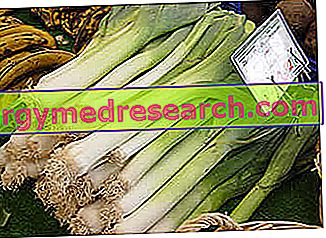Generality
The leek is a plant commonly used for food as vegetable or vegetable; the common one, called leek of the vines, belongs to the Liliaceae family and to the Genus Allium, just like onion, garlic, shallots and chives. The binomial nomenclature that identifies it is Allium ampeloprasum L.

It is a typical food of the Mediterranean basin, although its origin is probably due to more southern and eastern areas; in fact, the oldest leek cultivations date back to the classical period (Romans and Egyptians, to whom the spread to western cultures is probably due).
The leek grows luxuriant even with climates different from those of the territories of origin, as in Great Britain, provided that the soil is rocky, draining and possibly sandy; for the leek is ideal a crop arrangement near the coasts. In Wales, for example, they grow good quantities because, in addition to the gastronomic function, it is the national symbol.
From the leek of origin, perhaps through some crossings, other different varieties are then obtained; of these, three are the most widespread: common leek (the one spread almost all over the world, also in Italy), elephant garlic (Central Asia) and kurrat or Egyptian leek (Africa and Middle-East). In Virginia, the leek is known as the "Yorktown onion" (city of the USA).
Gastronomic uses and nutritional characteristics of leeks
Almost everything is eaten from the leek, eliminating only the roots and tips of the leaves. From the gastronomic point of view, the common tendency is to discard the whole green portion using only the white stem, then cut into rounds and stewed or used for cooking funds, sauces and broths; however, it is a useless waste: green leaves should be discarded only a few centimeters at the apex (about 2-3cm, depending on the size), while the rest can be washed, boiled, seasoned and used as a side dish. It should be noted that this is a preparation that is not appropriate for all palates, due to its fibrous consistency and strong taste.
The medicinal properties of the leek are mainly referred to the diuretic (also of the seeds) and laxative capacity; it is useful in the fight against renal lithiasis (renella and calculi), urine retention, dropsy (edema) and constipation. At one time it was believed that it could increase female fertility.
The leek is a vegetable low in calories and rich in fiber; proteins are scarce and fats almost absent. The energy supply is given mainly by fructose. Among the mineral salts and vitamins we do not appreciate particularly high or noteworthy quantities (although there are no translations of sodium - probably contained - and potassium - hypothetically in good quantities).
Nutritional values
Nutritional composition for 100 grams of edible part of raw leeks and cooked leeks (boiled in distilled water without adding salt):
| Leeks, raw | Leeks, cooked (boiled in distilled water without adding salt | ||
 | |||
| Edible part | 77, 0% | 100.0% | |
| water | 87, 8g | 86, 0g | |
| Protein | 2, 1g | 2.4 g | |
| Lipids TOT | 0.1g | 0.1g | |
| Saturated fatty acids | - mg | - mg | |
| Monounsaturated fatty acids | - mg | - mg | |
| Polyunsaturated fatty acids | - mg | - mg | |
| Cholesterol | 0, 0mg | 0, 0mg | |
| TOT Carbohydrates | 5, 2g | 5, 9g | |
| Complex glucides | 0.0g | 0.0g | |
| Soluble sugars | 5, 2g | 5, 9g | |
| TOT food fiber | 2, 9g | 2, 9g | |
| Soluble fiber | - g | g | |
| Insoluble fiber | - g | g | |
| Power | 29, 0kcal | 33, 0kcal | |
| Sodium | - mg | - mg | |
| Potassium | - mg | - mg | |
| Iron | 0, 8mg | - mg | |
| Football | 54, 0mg | - mg | |
| Phosphorus | 57, 0mg | - mg | |
| Thiamine | 0, 06mg | - mg | |
| Riboflavin | 0, 08mg | - mg | |
| Niacin | 0, 50mg | - mg | |
| Vitamin A | tr | - µg | |
| C vitamin | 9, 0mg | - mg | |
| Vitamin E | - mg | - mg | |



